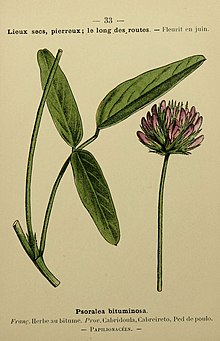Common asphalt clover
| Common asphalt clover | ||||||||||||
|---|---|---|---|---|---|---|---|---|---|---|---|---|

Common Asphalt Clover ( Bituminaria bituminosa ) |
||||||||||||
| Systematics | ||||||||||||
|
||||||||||||
| Scientific name | ||||||||||||
| Bituminaria bituminosa | ||||||||||||
| ( L. ) CHStirt. |
The ordinary asphalt Klee ( Bituminaria bituminosa ), also resin clover or pitch Klee called, is a plant from the genus asphalt Klee ( Bituminaria ) within the family of the Leguminosae (Fabaceae).
description
Vegetative characteristics
The common asphalt clover is a perennial herbaceous plant with a woody base and reaches heights of 20 to 100 centimeters. The aboveground parts of the plant are more or less closely hairy. All parts of the plant smell intensely of tar (hence the name); this smell is intensified when rubbing leaves or stems.
The alternate leaves are arranged in a petiole and a leaf blade. The petiole is relatively long. The leaf blade is three-part pinnate unpaired. The whole-edged and glandular dotted pinnate leaves are ovate to elliptical with a length of 1 to 6 centimeters and a width of 0.5 to 3 centimeters.
Generative characteristics
The flowering period extends from April to August. On the side there are 10 to 30 centimeter long inflorescence shafts, under which there are two to three-toothed bracts . In up to 3.5 centimeters large, head-shaped inflorescences 7 to 30 flowers are close together.
The hermaphrodite flowers are zygomorphic and five-fold with a double flower envelope . The calyx is 12 to 18 millimeters long and hairy. The blue to dirty purple crown has the typical shape of the butterfly flower. The flag is longer than the wing and the shuttle .
The single-seeded legume ends in a 11 to 20 millimeter long, sword-shaped beak.
The number of chromosomes is 2n = 20.
Occurrence
The asphalt clover is common throughout the Mediterranean , from the Canary Islands and Madeira in the west to the Black Sea, the Caucasus and Arabia in the east. Locations are roadsides, dry meadows, bushes, as well as fallow and ruderal areas.
Taxonomy
The first publication took place in 1753 under the name ( Basionym ) Psoralea bituminosa by Carl von Linné in Species Plantarum , page 763. The new combination to Bituminaria bituminosa (L.) CHStirt. was published in 1981 by Charles H. Stirton in Bothalia , Volume 13, Page 318. More synonyms for Bituminaria bituminosa (L.) CHStirt. are: Aspalthium bituminosum (L.) Fourr. , Psoralea palaestina Gouan .
literature
- Dankwart Seidel: Flowers on the Mediterranean. Determine accurately with the 3-check . BLV, Munich 2002, ISBN 3-405-16294-7 .
Individual evidence
- ↑ Peter Schönfelder , Ingrid Schönfelder: The new cosmos Mediterranean flora. Franckh Kosmos Verlag Stuttgart 2008, ISBN 978-3-440-10742-3 . P. 206.
- ↑ Bituminaria bituminosa at Tropicos.org. In: IPCN Chromosome Reports . Missouri Botanical Garden, St. Louis
- ^ Asphaltium in the Germplasm Resources Information Network (GRIN), USDA , ARS , National Genetic Resources Program. National Germplasm Resources Laboratory, Beltsville, Maryland. Retrieved August 22, 2020.
- ↑ Data sheet Bituminaria bituminosa In: The Euro + Med PlantBase - the information resource for Euro-Mediterranean plant diversity with data from ILDIS World Database of Legumes , which were taken over in 2010.
Web links
- Thomas Meyer, Michael Hassler: Mediterranean and Alpine flora : Genus: Bituminaria (asphalt clover) - data sheet with photos and identification key.

